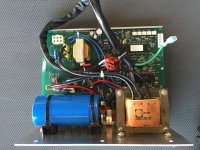I recycled a 110v, 3-phase motor from a treadmill that I wish to use on a 20" disk sander that I have built. The motor is a weird animal. Will this motor work for the sander? What would it take to get it to run off standard 110v power? Just want to be able to turn it on/off and vary the speed.
Motor Specs:
Emerson J55WZOBP-0014
115v, 3-phase, ~2hp, 3900 max rpm, Code A, 12.0 Amps, 12.0 SFA, Class F, Continuous rated, Thermally protected.
Motor Specs:
Emerson J55WZOBP-0014
115v, 3-phase, ~2hp, 3900 max rpm, Code A, 12.0 Amps, 12.0 SFA, Class F, Continuous rated, Thermally protected.









